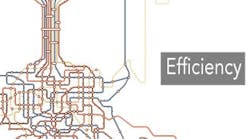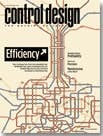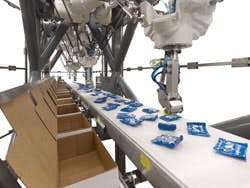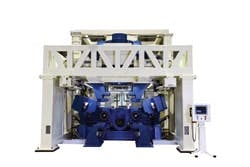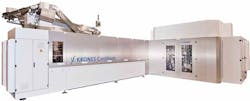Jim Montague is the executive editor for Control. Email him at [email protected].
SEE SIDEBAR STORY: Two Avenues to Machine Efficiency and Sustainability
|
|
Consequently, not only are there many routes to efficiency and sustainability, there are many applications for which new tools and methods gained along the way can be tried and adjusted to best meet individual needs. The only snag is that efficiency and sustainability require some extra investment up front. Even though green projects usually pay for themselves pretty quickly, it can be very difficult to convince many builders and end users to try them. So advocates must quantify the financial gains that efficiency and sustainability can deliver, and convince their accountants and managers to invest. Still, the fact that doubters are many and innovators are few is nothing new either — so why wait to get started?
Users Demand Air, Power Savings
"In the past, we had to push for it, but attitudes have been changing, and now many customers ask for greater energy efficiency," says Terry Zarnowski, sales and marketing director at Schneider Packaging Equipment in Brewerton, N.Y. "The retail giants require energy-saving initiatives, such as Wal-Mart's Sustainability Scorecard, and so our end users look at their production lines and machines. They're realizing that being green can also mean saving green, and that efficiency and sustainability can be a big part of their overall value equation. Luckily, there are still a lot of ways to save energy."
Source: Schneider Packaging EquipmentTo increase the efficiency of typical machines such as its case packers, Schneider performs an energy audit of the equipment and how it's operated, and then makes recommendations and presents options to users. For example, Schneider has long worked with SMC to evaluate and improve pneumatic performance, and recently collaborated with SMC to upgrade its standard case packers and cartoners, such as its RVCL-HS robotic vertical carton loader (Figure 1).
"We analyzed the machine's design, and SMC suggested ways to reduce compressed air usage and power consumed by right-sizing cylinders and air lines, adding a simple leak-detection system and shutting off valves when upstream product isn't coming," Zarnowski explains. "Implementing these changes added about $7,500 to the cost of the machine, but they save about $5,700 per year in the cost of producing air, and so the payback was only about 16 months. Our customer bought multiple machines, and is enjoying the ongoing savings."
Sustainability has become an umbrella term for efficient machine design and operations, as well as energy efficiency, reports Christopher Zei, global industry group vice president for the OEM business at Rockwell Automation. "Machine builders always have an eye on efficiency by minimizing downtime, reducing waste and material costs, using more accurate motion control, and using less pneumatics to save," he says. "Lately, they're using more intelligent variable-frequency drives (VFDs) and servo drives, and adding feedback devices that can serve out data for analysis."
Regen Brakes for Helicopter Testing
Of course, the most logical and popular way to improve sustainability is to replace old, inefficient motors and drives with newer, more efficient versions. The only difference is that now everyone's getting into the act.
For example, test-stand and assembly-line builder RedViking in Plymouth, Mich., recently was asked by the U.S. Department of Defense (DoD) to help upgrade and manage 20 stands for dynamic performance testing of helicopter transmissions, mostly Apache and Blackhawk classes. These single-purpose stands were 20–50 years old, required too much maintenance, used excessive power, took up too much space, didn't have enough spare parts, required unique training, and didn't produce the right data. Likewise, the units under test (UUTs) required too much time to build, dress, perform, disconnect and remove from the envelopes in the stands, and so the DoD's users could do only one test per shift, instead of the three or four it needed.
To allow the stands and carriages to shift the heavy transmissions and other UUTs, RedViking reviewed its options and picked asynchronous motors up to 3,000 hp and ac flux vector drives with regenerative braking packages enabled by 480 and 690 V drives, all from Siemens Industry's Drive Technology division. The motors simulate the power generated by a helicopter's jet engines and loading on its main rotor and tail output blades, and test its transmission to full speed and torque requirements with precise, closed-loop control. Meanwhile, the regenerative brakes allow the stands and other systems to recover power, and save up to 40% on energy. Conventional dynamic load testing requires loading to occur via an eddy current or fluid brake system, which incurs added energy, maintenance and costs.
SEE ALSO: Sustainable Machine: More Than an Add-On
"We estimate that a typical test on our Main Transmission Flexible Test System running at full capacity will cost about $400 less per hour to operate than comparable systems, and could save approximately $500,000 per year in power savings," says Jason Stefanski, RedViking's controls and software manager. On its Tail and Intermediate Gearbox Flexible Test Module, he adds, RedViking found that using two more motors was less expensive and more efficient than the previous test stand's gearbox design. This solution involves multiple motor connections to an output VFD with auxiliary connections, which eliminated the need for more VFDs.
"It's typically the manufacturer or the end user who leads the way with the initiatives to produce green/sustainable operations," adds Ken Kerns, marketing manager for Siemens' Motion Control division. "However, understanding that the trend is headed in the sustainable/energy-efficient direction, some OEMs are incorporating that mentality into their designs. Many already recognize that maximizing the efficiency of a machine is a viable selling point."
Most motors, drives and power components have internal energy monitoring equipment and parameters in firmware, but now their information needs to be available externally, adds Phil Kaufman, Rockwell Automation's business manager for industrial energy. One of the new avenues for reporting energy performance data is expected to be the CIP Energy protocol launched recently by ODVA. Rockwell Automation already has added CIP Energy functions to several drives, overload relays and smart motor controllers.
"The first step is monitoring to understand the amount of energy consumed, and then apply controls and close the loop to improve performance, and finally enable OEMs and users to jointly look for how they use energy and where to save it during shifts, breaks, nights, changeovers, jams, repairs and maintenance periods," Kaufman says. "To make further sustainability gains, machine builders must talk to their users about how their production lines and plant behave, including present efficiency, mean time to failure (MTTF), quality issues and overall equipment effectiveness (OEE). Next, given their users' needs, builders must seek to better understand their own equipment and machinery architectures. For instance, there's no point in putting a machine in low-power state for 45 minutes if the user needs it back up in 30 minutes."
Servos Speed Up Sustainability
More recently, servo motors and drives have been improving accuracy and control in many machines and production lines, which means they can contribute to new levels of efficiency and sustainability, and some can increase speed and reduce power consumption at the same time.
"Until now, belt drives were sufficient to drive the various wheels," says Dieter Finger, head of electrical development at Krones Plastics. "With the new Contiform, however, we're dealing with speeds at which inherent belt stretch keeps us from achieving the precision needed for a smooth transition between the blowing wheel and the transfer wheel." He and colleagues solved this problem by replacing the belt drives with direct drives, and giving Contiform 336 torque motors that deliver up to 2,300 Nm of torque.
"These torque motors not only are much more precise than belt drives, but their power management system allows them to share power in the event of an outage or emergency stop," Finger explains. "This means they can bring the machine to a stop quickly without losing synchronization." Contiform 336's torque motors are controlled by Krones' servo drive control (SDC), which allows unlimited axes to be coupled via Powerlink. SDC is based on B&R Industrial Automation's Acoposmulti inverters and an X20 CPU acting as controller.
Tubular Motors for Electric Stretching
Contiform 336's great speed is achieved by more than its torque motors. Krones' engineers also replaced pneumatic drives on stretch rods in the blow stations with custom-made, tubular linear motors from NTI. Unlike conventional flat or U-channel linear motors, this design has a permanent magnet slider rod that moves inside a stator tube, which holds the drive coils and a Hall sensor. The tubular linear motor eliminates the belts and play associated with standard stretch-rod drive solutions. Because force is translated directly into extending the stretch rod, Krones could also use much smaller bearings, making its new tubular linear motor greaseless and maintenance-free.
SEE ALSO: Energy Efficiency for Machines: The Smart Choice for Motorization
"The specifications required that the tubular motor provide a maximum force of 2 kN and achieve a top speed of 2 m/s," Finger adds. "We also needed positioning precision of 0.2 mm, while integrating the motor seamlessly into the rest of our drive solution." To meet these specifications, the motor was designed to operate with a standard three-phase drive with 800 Vdc bus voltage, which also evaluates and linearizes the Hall sensor's signal. "As a result, we now have company-standard tubular linear motors that combine very homogeneous movements with minimal power consumption."
Finger says electric stretching not only boosts output, but it also allows bottle types to be selected with the push of a button, eliminating the time-consuming task of manually switching out heads. "One button push is also all it takes to modify the movement profile of the stretch drive," he says. "So, when switching from a small bottle to a large bottle, it's no longer necessary to switch out the curve as well."
For the inverters controlling the linear motors, Krones selected Acoposmulti 65 with IP65 protection and an X20 CPU to control the blowing module. "Installing this inverter directly on each stretching station lets us produce the entire station in advance, test it, and parameterize it," Finger says. "We also only need one supply line for each station. This not only fits with our modular approach, it also supports the assembly line production strategy we're using for the first time with these machines."
Finally, the inverters allow Contiform 336 to extend its dc bus supply up to 70 m, as well as feed power back into the dc bus during normal operations. For example, the up to 650 N generated during stretch rod braking can be sent back and used by other stations, which enables each station to use only 250 W. This and a new intermediate-stage blow stage and improved compressed air recycling system allowed Krones to reduce the compressed air requirement by one third.
Similarly, Howard Dittmer, vice president of engineering and technology at Arpac Group in Schiller Park, Ill., reports his company's XLR8 horizontal form, fill and seal (HFFS) machine usually has two servo-controlled axes along with several pneumatics lines, but adds they're two-thirds along with designing a version with eight servos and no pneumatics, which will provide more speed, less downtime and save energy.
"However, we have to be careful because sometimes it's best to stay with an old, all-pneumatics machine if it can still provide a big performance benefit," Dittmer says. "We especially have to check energy costs, see if the pneumatics-based machine still can pay for itself, and compare it with the better throughput, less downtime and reduced maintenance we may get with newer equipment. At some point, we'll get good enough performance to get rid of pneumatics, and that's the long-term goal."
Handling New, Fewer Materials
Probably the most important prize to be won in sustainability efforts is redesigning machines and production lines to use fewer raw materials. Sustainability affects all aspects of how Arpac designs and builds its packaging machines, how its users operate them, and how it can help them produce greener products, Dittmer explains.
"Many customers ask us to help them make thinner and lighter packaging, so they can transport more products, but still save fuel," he says. "So we've been looking at getting rid of corrugated cardboard and using more, lighter shrink film, which also requires less compressed air. In fact, we're working with one consumer goods manufacturer to get rid of corrugated completely, and use double-wrap film instead, which will save millions of dollars."
To replace corrugated with film, Arpac developed its Brandpac single-roll, shrink-wrapping machine, but found 18 months ago that it also could use the same equipment to replace paper wrapping of construction/building products on pallets, save materials by switching to film, and use just one shrink-film hood instead of the two usually needed for paper wrapping.
"Building materials are wrapped in dusty and gritty environments, so we had to change Brandpac's design to protect areas such as the film feed where abrasive products often cause problems and wear," Dittmer explains. "This also meant simplified parts, increased clearances and using lube-free chains to reduce places where the dust and grit could accumulate. And, we're optimizing the film feed's center lining functions by adding load cells. This lets us track and control forces between the pinch rollers without doing it manually, which will save a lot of time at start-up, control any side-to-side movement, and optimize film handling."
Choreographing, Learning New Dances
Besides reducing upfront energy costs with better motors and drives or reducing processed materials, many builders and their end users are rethinking their machine production procedures, product handling and placement, and other physical configuration and format changes to increase efficiency and improve sustainability.
For instance, Zarnowski reports that some of Schneider Packaging's users are moving from bags-in-cartons to standup pouches to save materials, and so Schneider has been configuring its case packers and carton loaders, such as RVCL-HS, to flip, orient and nest these multi-sized, triangularly shaped pouches, so more can fit into cases and onto pallets. "We don't want to ship air, so to reduce volume, we have to orient the pouches more tightly, and flip every other one," Zarnowski says. "We mostly use vision-guided robots from Fanuc Robotics with a front-end programming interface that we can configure by adding custom code blocks. The vision processor's 2D guidance locates products, while an encoder follows the conveyor and keeps track when the camera takes pictures. The robot's controller then captures the encoder counts and images, and tells the robot when and how to pick and place the products."
SEEL ALSO: Motor Efficiency: Cut the Cost
These vision-enabled robots also do product inspection, verify labels and orientation, and read barcodes, Zarnowski adds. Schneider Packaging usually employs a standard platform of CompactLogix PLCs and PanelView HMIs from Rockwell Automation to handle all the sensors, feedback devices, solenoids and other non-robot-specific I/O points on its RVCL-HS and other machines.
"We say that every product has its own personality," Zarnowski says. "Completing each flexible packaging task can be highly specialized and challenging, but we start with a successful end-of-arm tool design, which is critical. The master PLC controls the whole machine, except for the robot and vision system. Instead, they act as just another tool that reports to the master. Finally, our vision-guided robots give us the flexibility to handle these different personalities with less changeover, better OEE and greater sustainability."
Your Super Flexible Future
Just as the reach of machine efficiency has grown beyond saving energy to include sustainable production and products, this evolution is likely to keep expanding in widening circles to embrace more technologies, operations, and vertical and horizontal production processes.
"I think we'll see even more flexible formats in the future with denser packing, more SKUs, even shorter production runs, and packaging lines handling even more new product varieties," Zarnowski says. "However, there's always going to be some mechanical changeover needed, and so we just launched our ProAdjust automatic adjustment solution that controls motor gear reducers without requiring programming. This self-contained unit bolts onto a machine, and allows users to make simple screw adjustments via a touchscreen teach-pendant and Ethernet links to power packs that move the adjustment points. So, instead of spending 37 minutes to manually make a changeover to a different case size on one of our case erectors, we can use ProAdjust to do it in about seven minutes. Efficiency and sustainability are evolving on many fronts. We're already seeing more willingness by some manufacturers to collaborate with their machine builders earlier on because they want to maximize efficiency and sustainability throughout their machines, production lines and processes."
